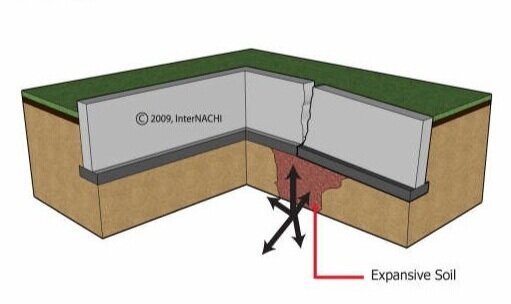Foundation Movement: the Terminology and the Physics
If you commission a structural inspection of your home’s foundation, the report you receive is likely to include certain technical terms. Some of these terms sound more complicated than they really are. In this post, we are going to decipher two common terms: lateral movement and vertical movement. We will then discuss physical forces that cause each type of foundation movement, and we will look at some of the clues a professional engineer might follow to determine which type of movement your foundation is experiencing and recommend appropriate remedial measures, if any.
Definitions: Lateral Movement and Vertical Movement
The two most common types of foundation movement are lateral movement and vertical movement. “Lateral movement” (or “horizontal movement”) refers to foundation movement in the horizontal plane, or sideways. In other words, this is a technical way of saying, “Your basement wall is pushing in.” “Vertical movement” refers to foundation movement in the vertical plane, or up and down. In other words, this is a technical way of saying, “This portion of your foundation is settling (downward),” or, “This portion of your foundation is heaving (upward).”
Now that we have the structural terminology down, let’s look at the physics.
A Likely Culprit: Expansive Clay Soil
What physical forces are to blame for foundation movement, in either direction? In Kansas City, there is a likely culprit: expansive clay soil. Expansive clay soil is common throughout the Kansas City metro area. This type of soil expands when it gets wet and shrinks when it dries.
As we have discussed in another post, the expansion is like combining dry rice with boiling water—one cup of dry rice turns into three cups of cooked rice. As the wet soil around your foundation expands, the weight of the water and the expanded soil exert increasing pressure on your foundation walls. This force can be strong enough to push your foundation walls inward, resulting in lateral movement, or heave your foundation upward, resulting in vertical movement.
The shrinking of clay soil in very dry conditions can also cause structural problems. Shrinking soil can pull away from your foundation walls, which can have several effects. First, as soil pulls away, the resistant force (e.g., friction) exerted by the soil on the foundation walls is reduced, which increases the freedom of movement of the walls. Second, where soil has pulled away, it leaves a void to be filled with water during the next heavy rain. This water can exert significant pressure on your foundation walls, increasing the risk of lateral movement. And third, shrinking soil can create voids under the foundation footings, which can lead to settlement.
Although a common culprit, expansive clay soil isn’t the only factor to blame for foundation movement. Other factors that can contribute to foundation movement include freezing conditions (and the associated expansion of water in the soil), large trees near the foundation (which pull water out of the soil during times of extreme drought and thus cause soil to shrink), poor drainage (which exacerbates the effects of expansive clay soil), and poorly compacted soil or improper backfilling around the foundation (most applicable to new homes that were constructed in the last 1-3 years).
Signs of Lateral and Vertical Movement
Before undertaking costly foundation repairs, it is important to understand what type of movement your foundation is experiencing, because you want a solution that is tailored to your foundation problem. A professional engineer can perform a structural inspection of your foundation in order to diagnose your problem and recommend an appropriate solution. You can then work with the contractor of your choice to implement the solution.
There are a few things a professional engineer can do during a structural inspection of your foundation in order to identify lateral movement. Measurements may be taken to determine how far a wall has moved inward. Additionally, certain cracks are characteristic of lateral movement. For example, as shown in Figure 1, a horizontal crack can occur where expansive soil is exerting significant pressure on a foundation wall and pushing it inward. Notably, other types of cracks can indicate lateral movement, too, so the absence of a horizontal crack does not necessarily mean lateral movement has not occurred. If a professional engineer observes excessive lateral movement, he or she might recommend braces, wall anchors, straightening the wall, or even replacing the wall.
Figure 1: Lateral foundation movement evidenced by a horizontal crack. (Reproduced with permission from InterNACHI.)
A professional engineer may also take measurements and make visual observations to identify vertical movement. A laser level can be helpful in assessing the extent of vertical movement in a particular area. Additionally, certain cracks are characteristic of vertical movement. For example, as shown in Figure 2, a vertical V-shaped crack (wider at the top than at the bottom) may occur when expansive soil damages a footing and the foundation on one side of the crack settles downward more than the foundation on the other side of the crack. Over time, some settlement is to be expected. But if excessive settlement has occurred, a professional engineer might recommend underpinning the foundation with piers.
Figure 2: Vertical foundation movement (settlement) evidenced by a vertical v-shaped crack. (Reproduced with permission from InterNACHI.)
A word of caution is appropriate here. Cracks can be tricky to diagnose. In fact, many cracks pose no structural concerns and require no remedial action. Hiring an independent professional engineer to perform a structural inspection of your foundation and provide an unbiased assessment might save you unnecessary worry—and money.
If you have questions regarding potential foundation movement, Schroeder Engineering is here to help. Contact us today for an independent structural assessment of your foundation by a professional engineer.



